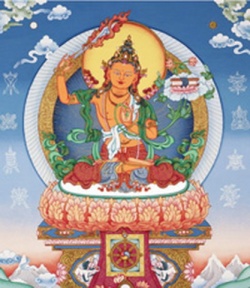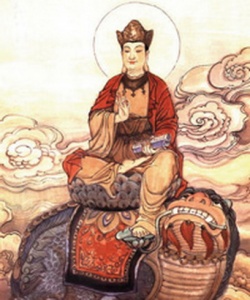Chinese Manifestations of Tibetan Buddhas - Manjushri
One of the most wonderful dimensions of the Mahayana Tradition of Buddhist practice and teaching are the different manifestations of Buddha’s Qualities of compassion and wisdom. These emanate as different Buddha deities. The form, appearance, costumes, mudras, implements and jewellery of these Buddha deities differ quite considerably under Chinese & Tibetan Buddhism. Chinese & Tibetans follow the Mahayana tradition and we bring you images of five of the more popular Tibetan Buddha deities in their Chinese manifestation.
Manjushri - The Buddha of Wisdom
The Sanskrit name for the Buddha of Wisdom is Manjushri. In Chinese he is known as Wen-shu Pusa and in Tibetan Jampalyang.
The word Manju means charming, beautiful and pleasing, and Shri means glory and brilliance. Manjushri is regarded as the crown prince of the Buddha’s teachings, the one who best explains Buddha’s wisdom. Manjushri has this title because eons ago, he was the instructor for seven Buddhas, the last being Shakyamuni Buddha. As one of the ancient Buddhas, Manjushri vowed, "I shall be the Guide to lead all Bodhisattvas to achieve the state of complete enlightenment. Until this vow is fulfilled, I will not become a Buddha."
Manjushri is depicted with his right hand holding a double-edged flaming sword and his left hand holding an utpala (blue lotus) flower on which rests the Prajnaparamita (Perfection of Wisdom) Sutra.
He is often seen riding a green lion. The Prajnaparamita Sutra on the utpala flower symbolizes wisdom pure as lotus. The sword symbolizes the sharpness of wisdom that cuts through illusions. A lion is the king of the animal kingdom, thus riding on a green lion symbolizes Manjushri’s majesty of wisdom that surpasses all other Bodhisattvas.
In China, Manjushri is portrayed as a youth with five topknots. This signifies that the profound wisdom is as true, as non-dualistic, as pure and as innocent as a child’s mind. When one’s mind is in such state, one can reflect the truth of everything. The five topknots are the five aspects of Buddha’s wisdom:
1) the Mirror-like Wisdom,
2) the Wisdom of Equanimity,
3) the Wisdom of Analysis,
4) the Wisdom of Achieving Activities, and
5) the Wisdom of the Nature of Phenomena.
The Chinese Manifestation of Manjushri
is known as Wen Shu Pusa
In China the sacred site of Manjushri is Wu-Tai Shan in the province of Shan-Xi in eastern China. As described in a sutra, Shakyamuni predicted that after entering nirvana, Manjushri would reside on a mountain named Wu-Tai in an eastern country named the “Great China,” where he would spread the Mahayana doctrine of the Buddha’s Dharma.
Manjushri not only plays an important role in many of Shakyamuni Buddha’s philosophical discourses, he also figures prominently in legends that originated in Buddha’s time which are still widely known today. One of the most famous of these tells of Manjushri’s encounter with a group of Buddha’s disciples who were on the verge of achieving nirvana, the self-liberation of Arhatship, under the guidance of Arya Shariputra.
Confronting them, Manjushri declared his belief that there was something far more worthy to strive for than mere self-liberation, namely the full-awakening of Buddhahood. He explained to them the compassionate bodhicitta motivation, and taught them the Path leading to perfect enlightenment for the sake of others.
The disciples, on hearing that became very upset to learn that the goal of their intense practice – nirvana – had been relegated to an inferior status. They retaliated by maligning the Bodhisattva path which Manjushri had just revealed to them. As a result of the anger they generated towards this exalted teaching, their previous realizations degenerated and, not only did they fail to achieve Arhatship, but after their deaths they were reborn in the suffering hell realm!
Astounded by what he had witnessed, Arya Shariputra went directly to Shakyamuni Buddha and asked the Omniscience One to explain the meaning of Manjushri’s actions.
The Buddha answered him as follows, "What you saw was an example of Manjushri’s great compassionate wisdom. Had those disciples achieved nirvana it would have taken eons to awaken them from the bliss of their self-liberation so that they could work for the benefit of others. Because of Manjushri’s intervention, however, when these disciples emerge from their suffering rebirth – having burnt and purified the harmful effects of their anger and narrow-mindedness – the imprints of the Bodhisattva path placed on their mental continuum will arise strongly in their minds. Following this Path they will achieve full enlightenment swiftly, thereby bringing supreme benefit not only to themselves but to countless others as well."
This story helps illustrate the way in which Manjushri’s enlightened and compassionate wisdom offers protection from what are often referred to as the "two fears", those of samsara (cyclic existence) and nirvana. Concerning the former, Manjushri’s sword of wisdom destroys the false and misleading conceptions fabricated by the root of all negativities – ignorance, thereby offering ultimate protection from the fears of cyclic existence.
As for the second fear – that of nirvana or solitary peace – at first sight this appears to involve a serious contradiction in terms. After all, what is there to fear when the root cause of all personal suffering has been eliminated forever? As the story of Manjushri and those would-be Arhats show, what is fearful about the peace of self-liberation is not one’s own suffering – for this has been totally eradicated – but rather the way this blissful liberation breeds complacency and indifference to the suffering of others.
Such indifference is the very antithesis of the compassionate Bodhicitta motivation to gain enlightenment for the sake of benefiting others. Manjushri’s insightful attitude, imbued as it is with this compassionate motivation, never lose sight of the welfare of those who, like ourselves, wish only to be happy and do not wish even the slightest suffering. This altruistic attitude guards us from the "fear" of striving for our own release to the neglect of all other self-imprisoned beings.

